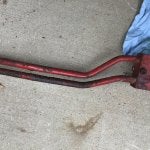I was doing a installation on our tractor. I lifted the rear hydraulic tubes about a inch. I think the age ,corrosion not sure , but I have open a leak somewhere.
Can I use braze to repair the thin wall steel tubing ?
I just wondering cause I have not pin pointed the leak just yet .
Can I use braze to repair the thin wall steel tubing ?
I just wondering cause I have not pin pointed the leak just yet .










